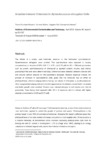Atrazine-Induced Chlorosis in Synechococcus elongatus Cells

Use this link to cite
http://hdl.handle.net/2183/13710Collections
- Investigación (FCIE) [1228]
Metadata
Show full item recordTitle
Atrazine-Induced Chlorosis in Synechococcus elongatus CellsDate
2004Citation
González-Barreiro Ó, Rioboo C, Cid A, Herrero C. Atrazine-induced chlorosis in synechococcus elongatus cells. Arch Environ Contam Toxicol. 2004;46(3):301-7.
Abstract
The effects of a widely used herbicide, atrazine, on the freshwater cyanobacterium Synechococcus elongatus were studied. The cyanobacteria were exposed to varying concentrations of atrazine (0.025, 0.05, 0.1, 0.25, and 0.75 µM) for 96 h. Different parameters such as growth, autofluorescence of chlorophyll a, pigment content, volume, and internal granularityof the cells were determined daily. Differences were detected between cultures with and cultures without atrazine for the parameters analyzed. Atrazine exposure induced the process of chlorosis in cyanobacterial cells, given that this herbicide has an effect on photosynthesis, chlorotic subpopulations having low values of chlorophyll a autofluorescence. More unpigmented subpopulations (chlorotic) appeared as the atrazine concentration increased and better growth rates resulted. Atrazine also induced changes in cell volume and internal granularity, these being most apparent after 48 h of exposure and in cultures with higher atrazine concentrations (0.25 and 0.75 µM).
Keywords
Herbicide
Atrazine
Cyanobacteria
Chlorosis
Chlorotic cells
Synechococcus elongatus
Cytometry
Atrazine
Cyanobacteria
Chlorosis
Chlorotic cells
Synechococcus elongatus
Cytometry
Editor version
Rights
The final publication is available at link.springer.com





